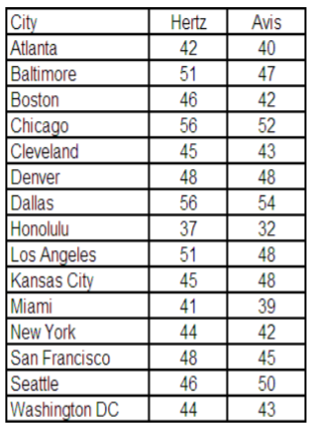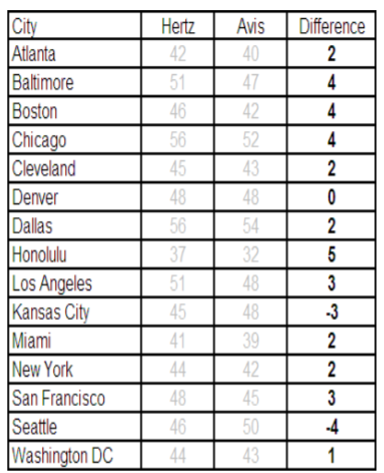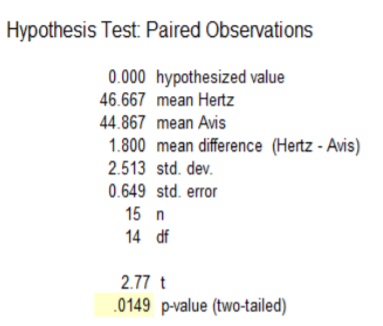11.3: Dependent Sampling – Matched Pairs t‐test
- Page ID
- 20915
The independent models shown above compared samples that were not related. However, it is often advantageous to have related samples that are paired up – two measurements from a single population. The model we will consider here is called the matched pairs \(t\)‐test also known as the paired difference \(t\)‐test. The advantage of this design is that we can eliminate variability because other factors are not being studied, increasing the power of the design.
In this model we take the difference of each pair and create a new population of differences, so if effect, the hypothesis test is a one population test of mean that we already covered in the prior section.
Model Assumptions
- Dependent Sampling
- \(X_{d}=X_{1}-X_{2}\)
- \(\overline{X}_{d}=\overline{X}_{1}-\overline{X}_{2}\) approximately Normal
Test Statistic
- \(t=\dfrac{\overline{X}_{d}-\mu_{d}}{s_{d} / \sqrt{n}}\)
- \(d f=n-1\)
Example: Rental cars
An independent testing agency is comparing the daily rental cost for renting a compact car from Hertz and Avis.

A random sample of 15 cities is obtained and the following rental information obtained.

At the .05 significance level can the testing agency conclude that there is a difference in the rental charged?
Notice in this example that cities are the single population being sampled and that two measurements (Hertz and Avis) are being taken from each city. Using the matched pair design, we can eliminate the variability due to cities being differently priced (Honolulu is cheap because you can’t drive very far on Oahu!)
Solution
Design
Research Hypotheses:
\(H_o: \mu_{1}=\mu_{2}\) (Hertz and Avis have the same mean price for compact cars.)
\(H_a: \mu_{1} \neq \mu_{2}\) (Hertz and Avis do not have the same mean price for compact cars.)
Model will be matched pair t‐test and these hypotheses can be restated as: \(Ho: \mu_{d}=0 \quad Ha: \mu_{d} \neq 0\)
The test will be run at a level of significance (\(\alpha\)) of 5%.
Model is two‐tailed matched pairs \(t\)‐test with 14 degrees of freedom. Reject \(H_o\) if \(t < ‐2.145\) or \(t >2.145\)
Data/Results

We take the difference for each pair and find the sample mean and standard deviation.
\(\begin{aligned}
\overline{X}_{d}&=1.80 \\
s_{d}& = 2.513\\
n &= 15\\
t&=\dfrac{1.80-0}{2.513/\sqrt{15}}=2.77
\end{aligned}\)

Reject \(H_o\) under either the critical value or p‐value method.
Conclusion
There is a difference in mean price for compact cars between Hertz and Avis. Avis has lower mean prices.
The advantage of the matched pair design is clear in this example. The sample standard deviation for the Hertz prices is $5.23 and for Avis it is $5.62. Much of this variability is due to the cities, and the matched pairs design dramatically reduces the standard deviation to $2.51, meaning the matched pairs t‐test has significantly more power in this example.


